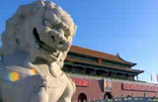A Singaporean artist showcases the global village in Beijing
Updated: 2015-06-17 07:46
By Lin Qi(China Daily)
|
|||||||||||
Ming Wong frequently centers around the issue of cultural identity in his works. The Singaporean artist, 44, spent years studying in London and currently lives and works in Berlin.
Wong bases his visual system on questioning the influence of globalization. "The more internationalized we become, the more difficult we feel it is when seeking uniqueness as an individual."
Wong's works shed light upon common phenomena of a global village: The cultural differences are fading away. People are confused by ethnic identity.
Wong's current solo exhibition at Ullens Center for Contemporary Art in Beijing, titled Next Year, shares his insights into these serious subjects, with only two works. The video Next Year/L'Annee Prochaine was filmed in Shanghai in May. When he attended the Shanghai Biennale last year, Wong was impressed by the city's unique architecture that integrate European and Chinese styles. "The buildings are accumulations of time and history. Meanwhile Shanghai is becoming the backdrop of many sci-fi movies."
Wong also found a cafe called Marienbad, named after the French New Wave film classic Last Year at Marienbad. That further inspired him to create a work that has something to do with France. Wong reinterpreted the 1961 film. He played in different scenes two characters of the film: a woman referred to as A and a man as X.
In the original film, X claims he and A met a year before while A denies they've ever met. Wong re-adapted the scenario to a sci-fi plot: The two characters time travel back to the year they met.
The work is in black and white and in French with Chinese and English subtitles. As it is with the original one, Wang narrated in a dreamlike structure, in which reality, memory and illusion are hard to distinguish.
Wong largely filmed at the Fuxing Park and Cite Bourgogne, both in the former French Concession. The park is designed in a French style combined with features of a Chinese garden.
The compound of Cite Bourgogne was built in 1930 and named bugao li (alley) in Chinese. The historic site preserves traditional pai lou (arched gates) and restored shikumen-style buildings with the long laundry poles, typical of Shanghai's old neighborhoods.
Wong didn't clear out spectators when filming at the locations. The takes in the park show in the backdrop elderly people playing mahjong; in the scenes at Cite Bourgogne, residents cast curious glances at Wong and another actor.
Wong presents in the work a confusion of time and space.
"It looks quite vintage. It makes you feel nostalgic for the sentiment of Europe in the 1930s and '40s. But if you watch attentively, you will find the work is all about the future," he says.
"Walking down the lanes in Shanghai, I don't know exactly where I am, whether I'm in the past or at present, in China or France, in an upscale or underprivileged area.
"Conflict and instability, that's what I want the work to be with," Wong adds.
Wong's interest in cultural identity and time also led him to study Cantonese Opera and sci-fi movies. His progress in researching the two fields, which are seemingly irrelevant, triggered the birth of Scenography for a Chinese Science-Fiction Opera, the other work displayed.
Wong converted the nave of Ullens Center for Contemporary Art into a 3-D theater stage. A dozen wooden boards that reach the ceiling divide the space into two settings. The boards in the first setting were painted like the interior of a spaceship; in the second setting, the patterns of Chinese-style auspicious clouds on the boards form a traditional opera stage. Wong found inspiration in the painted murals in the Dunhuang Mogao Grottoes.
"Dunhuang cave art presents how the ancient Chinese perceived the universe, and how the sheer power of imagination motivated them to produce colors so full of tension," he says.
Visitors walk past the boards and through time. Then they come to the end and the climax, a huge, rotating and circular board with vivid colors.
Wong's studies of Cantonese Opera extended his attention to the film history of Hong Kong. He found that Cantonese Opera looked to the future in the process of being modernized by filmmaking.
"Opera performers also acted in movies. They often performed for Cantonese immigrants in California, from where they brought back home moviemaking techniques. They employed scenarios of Hollywood movies, and they adapted arias into pop melodies.
"Cantonese Opera absorbed various elements from outside. It has evolved to become a flexible art form that tells all kinds of stories and addresses any topic," he says.
Wong plans to make a film in the form of Chinese opera but about sci-fi subjects. He will incorporate an investigation of young opera performers. He is interested in how they switch between the circumstances of a long-standing art form and metropolitan life.
linqi@chinadaily.com.cn
(China Daily 06/17/2015 page18)
Today's Top News
China looks for a place in EC investment fund
Bank of China joins gold auction as first Asian bank
JF-17 fighter makes debut at Paris air show
Russia says will retaliate if US weapons stationed on its borders
Migrant crisis deepens in Italy, interior minister urges EU response
Greece and creditors fail in 'last attempt' to reach deal
Former Chinese top legislator Qiao Shi dies in Beijing at age 91
Alibaba to launch Netflix-like video streaming service
Hot Topics
Lunar probe , China growth forecasts, Emission rules get tougher, China seen through 'colored lens', International board,
Editor's Picks

|

|

|

|

|

|






